
|
It brightened up to 6.0 mag in mid May (May 14, Chris Wyatt). It will be fading after this. But it is bright as 6.6 mag still now (May 26, Marco Goiato). In the Southern Hemisphere, it keeps observable in good condition until late June. In the Northern Hemisphere, it keeps unobservable until September when the comet will be fainter than 13 mag.
Date(TT) R.A. (2000) Decl. Delta r Elong. m1 Best Time(A, h)
May 30 7 7.00 -7 1.4 0.864 0.789 48 7.2 20:50 ( 86, -6)
June 6 7 31.85 -1 18.3 1.107 0.821 45 7.9 20:56 ( 92, -5)
|

|
It brightened up to 3.7 mag and became a naked eye comet in mid January (Jan. 13, Marek Biely). Now it is fading. But it is bright as 8.2 mag still now (May 31, Neil Norman). In the Northern Hemisphere, it keeps observable all night until July when the comet will fade down to 10 mag. Then it keeps observable for a long time until the comet fades out. It is not observable in the Southern Hemisphere.
Date(TT) R.A. (2000) Decl. Delta r Elong. m1 Best Time(A, h)
May 30 20 9.82 89 2.0 2.291 2.145 68 8.2 3:05 (180, 36)
June 6 15 15.15 86 27.1 2.338 2.219 70 8.4 22:09 (180, 39)
|
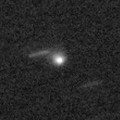
|
Now it is 10.7 mag (May 26, Michael Mattiazzo), fainter than originally predicted. It will approach to the sun down to 0.3 a.u. in July, and it was expected to brighten up to 3 mag. But actually, it will be 6 mag at best. In the Southern Hemisphere, it is observable in the extremely low sky until early June. Then it becomes unobservable temporarily, but it will be observable after mid July, and keeps observable while the comet will be fading gradually. It will not be observable after this in the Northern Hemisphere.
Date(TT) R.A. (2000) Decl. Delta r Elong. m1 Best Time(A, h)
May 30 2 31.95 18 5.5 1.806 1.011 26 10.3 3:05 (247, -1)
June 6 3 2.47 22 23.8 1.662 0.868 25 9.6 3:01 (243, 0)
|
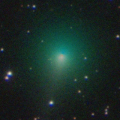
|
Now it is bright as 9.9 mag (May 24, Marco Goiato). In the Southern Hemisphere, it keeps observable in good condition for a long time until the comet fades out. In the Northern Hemisphere, it will be getting higher gradually after this, and will be observable in good condition while the comet will be fading gradually.
Date(TT) R.A. (2000) Decl. Delta r Elong. m1 Best Time(A, h)
May 30 0 36.97 -0 8.2 1.705 1.480 59 9.9 3:05 (278, 11)
June 6 0 53.82 1 35.3 1.696 1.511 61 10.1 3:01 (278, 14)
|
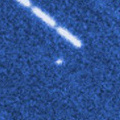
|
It brightened up to 12.8 mag until March (Mar. 21, Michael Mattiazzo). It will brighten up to 10.5 mag in May and June, but it is not observable. In the Northern Hemisphere, it will be observable after autumn while the comet will be fading.
Date(TT) R.A. (2000) Decl. Delta r Elong. m1 Best Time(A, h)
May 30 4 32.13 20 14.7 2.361 1.349 2 10.6 20:50 (133,-18)
June 6 4 55.26 22 34.9 2.367 1.352 0 10.6 20:56 (136,-18)
|
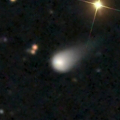
|
Now it is 12.3 mag (May 14, Chris Wyatt). It is expected to brighten up to 5 mag from autumn to winter. It keeps observable in excellent condition until autumn in the Southern Hemisphere. In the Northern Hemisphere, it is hardly observable until December.
Date(TT) R.A. (2000) Decl. Delta r Elong. m1 Best Time(A, h)
May 30 23 50.28 -25 26.6 2.742 2.781 81 11.2 3:05 (305, 4)
June 6 23 53.38 -26 54.1 2.535 2.695 87 10.9 3:01 (309, 7)
|
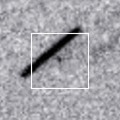
|
It will brighten up to 11 mag in April and May. But the condition is bad in this apparition. In the Southern Hemisphere, it is getting higher gradually in the morning sky. It will not be observable until late July in the Northern Hemisphere.
Date(TT) R.A. (2000) Decl. Delta r Elong. m1 Best Time(A, h)
May 30 2 27.71 2 35.7 2.418 1.682 34 12.0 3:05 (260,-10)
June 6 2 45.03 3 19.3 2.429 1.726 36 12.3 3:01 (260, -8)
|
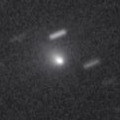
|
Now it is 12.7 mag and visible visually (May 15, Uwe Pilz). It will brighten up to 11 mag in 2015 autumn. In this apparition, it is observable until the highlight while the comet is brightening.
Date(TT) R.A. (2000) Decl. Delta r Elong. m1 Best Time(A, h)
May 30 12 21.34 5 4.2 1.478 2.112 114 13.0 20:50 ( 28, 57)
June 6 12 23.23 4 34.1 1.510 2.071 108 12.8 20:56 ( 39, 53)
|
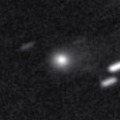
|
Now it is 14.3 mag (May 22, Yuji Ohshima). In 2015, it keeps 13-14 mag and will be observable in good condition for a long time.
Date(TT) R.A. (2000) Decl. Delta r Elong. m1 Best Time(A, h)
May 30 19 28.40 -8 29.8 2.710 3.492 134 13.1 3:01 ( 0, 47)
June 6 19 28.12 -8 23.2 2.660 3.502 140 13.1 2:33 ( 0, 47)
|

|
Outburst occured on May 6. Now it is bright as 11.3 mag (May 16, Marco Goiato).
Date(TT) R.A. (2000) Decl. Delta r Elong. m1 Best Time(A, h)
May 30 17 45.97 -31 48.1 5.080 6.039 159 13.4 1:19 ( 0, 23)
June 6 17 42.48 -31 46.3 5.048 6.037 165 13.4 0:48 ( 0, 23)
|
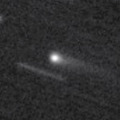
|
Now it is 13.5 mag (May 25, Hiroshi Abe). It is expected to brighten up to 12 mag from July to August. In the Southern Hemisphere, it keeps observable in good condition until summer. In the Northern Hemisphere, it will be getting higher gradually after May, and will be observable in good condition after summer.
Date(TT) R.A. (2000) Decl. Delta r Elong. m1 Best Time(A, h)
May 30 20 56.50 -26 6.6 1.197 1.903 118 13.7 3:05 (339, 26)
June 6 20 56.79 -22 1.9 1.088 1.859 124 13.4 3:01 (344, 31)
|
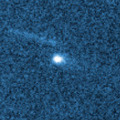
|
Now it is 15.5 mag (May 29, A. Maury, J.-F. Soulier, J.-G. Bosch, T. Noel). It will brighten up to 11 mag from August to October. In the Northern Hemisphere, it will be getting higher gradually after July, then it keeps observable in good condition. In the Southern Hemisphere, it keeps low until November.
Date(TT) R.A. (2000) Decl. Delta r Elong. m1 Best Time(A, h)
May 30 1 52.57 7 44.3 2.177 1.534 39 14.1 3:05 (261, 0)
June 6 2 13.90 9 56.3 2.110 1.489 40 13.8 3:01 (259, 2)
|
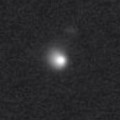
|
It brightened very rapidly. Now it is so bright as 13.8 mag and visible visually (May 11, Sandor Szabo). It keeps 14-15 mag for a while after this. In the Northern Hemisphere, it will be getting lower gradually after May, and will be unobservable in mid June. In the Southern Hemisphere, it will be getting lower gradually after June, and will be unobservable in early August.
Date(TT) R.A. (2000) Decl. Delta r Elong. m1 Best Time(A, h)
May 30 9 21.87 6 56.3 3.591 3.430 72 14.3 20:50 ( 77, 29)
June 6 9 28.92 6 20.4 3.677 3.428 67 14.3 20:56 ( 81, 23)
|
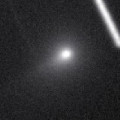
|
It brightened up to 9.2 mag in March (Mar. 9, Juan Jose Gonzalez). Now it is fading. It has already faded down to 14.8 mag (May 26, Hiroshisa Sato). In the Northern Hemisphere, it will be getting higher gradually after this. It is not observable after this in the Southern Hemisphere.
Date(TT) R.A. (2000) Decl. Delta r Elong. m1 Best Time(A, h)
May 30 2 1.64 65 31.4 2.191 1.718 49 14.7 3:05 (208, 29)
June 6 2 9.12 70 4.3 2.231 1.817 53 15.0 3:01 (204, 32)
|

|
It approached to the earth, and brightened up to 12.0 mag from April to May (Apr. 24, Taras Prystavski). Now it is fading, but it is bright as 14.5 mag still now (May 25, Hiroshi Abe). it will be fainter than 18 mag in late July. It is observable in excellent condition for a while.
Date(TT) R.A. (2000) Decl. Delta r Elong. m1 Best Time(A, h)
May 30 22 1.41 7 32.6 0.769 1.301 92 14.7 3:05 (300, 46)
June 6 22 7.60 13 21.7 0.792 1.343 95 15.1 3:01 (298, 53)
|

|
It brightened up to 6.9 mag in 2014 autumn (Oct. 17, Marco Goiato). Now it is fading. It has already faded down to 14.8 mag (May 22, C. W. Hergenrother). In the Southern Hemisphere, it keeps observable in good condition until the comet fades out. It will be observable again in mid June also in the Northern Hemisphere.
Date(TT) R.A. (2000) Decl. Delta r Elong. m1 Best Time(A, h)
May 30 0 55.39 -17 1.6 4.205 3.875 64 14.8 3:05 (289, -2)
June 6 0 55.56 -17 21.0 4.167 3.948 70 14.9 3:01 (293, 2)
|
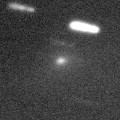
|
Now it is 15.2 mag (May 25, Hiroshi Abe). Distant object, but it keeps observable at 14-15 mag for a long time from 2015 to 2016.
Date(TT) R.A. (2000) Decl. Delta r Elong. m1 Best Time(A, h)
May 30 21 29.65 -0 59.3 5.214 5.535 103 15.0 3:05 (316, 45)
June 6 21 30.94 -0 47.8 5.091 5.512 109 14.9 3:01 (323, 48)
|

|
Now it is 17.1 mag (Apr. 27, Hidetaka Sato). First return of a comet re-discovered after 112-year blank in 2008. It brightened up to 12 mag in 2008. In this apparition, it was expected to brighten up to 15 mag from spring to summer, but it is fainter than predicted. It keeps locating low in the morning sky for a while.
Date(TT) R.A. (2000) Decl. Delta r Elong. m1 Best Time(A, h)
May 30 0 53.84 9 13.8 1.944 1.546 52 15.3 3:05 (268, 13)
June 6 1 13.60 10 18.6 1.919 1.555 53 15.3 3:01 (268, 15)
|
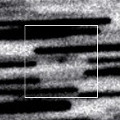
|
Now it is 17.0 mag (May 24, C. Rinner, F. Kugel, J. Nicolas). It is expected to brighten up to 15 mag in summer, and will be observable in excellent condition. However, it is fainter than this ephemeris recently.
Date(TT) R.A. (2000) Decl. Delta r Elong. m1 Best Time(A, h)
May 30 22 56.05 -3 43.5 1.507 1.730 84 15.4 3:05 (298, 29)
June 6 23 10.13 -2 15.9 1.458 1.734 87 15.3 3:01 (299, 31)
|

|
Now it is 15.3 mag (Jan. 7, Taras Prystavski). It keeps 15 mag for a long time from 2014 to 2015. It is observable in excellent condition in 2014 in the Southern Hemisphere, or in 2015 in the Northern Hemisphere. It will be getting higher gradually in the morning sky.
Date(TT) R.A. (2000) Decl. Delta r Elong. m1 Best Time(A, h)
May 30 1 52.29 17 29.4 4.713 3.941 36 15.3 3:05 (253, 6)
June 6 1 57.25 19 0.1 4.657 3.952 41 15.3 3:01 (254, 11)
|
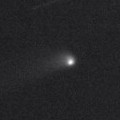
|
Now it is 15.8 mag (Feb. 22, Taras Prystavski). It will brighten up to 14 mag from 2015 to 2016. In the Southern Hemisphere, it becomes unobservable temporarily from April to May, but it will be observable in good condition again after June. It will be observable in good condition after July also in the Northern Hemisphere.
Date(TT) R.A. (2000) Decl. Delta r Elong. m1 Best Time(A, h)
May 30 3 7.38 3 37.0 5.149 4.262 26 15.4 3:05 (253,-17)
June 6 3 9.37 4 25.3 5.087 4.251 31 15.3 3:01 (256,-12)
|

|
Now it is 15.1 mag (Apr. 17, Taras Prystavski). It will pass close to the earth from spring to summer in 2016, and it is expected to be observable at 6-7 mag in good condition. It is not observable now. In the Northern Hemispehre, it will appear in the morning sky in late July, then it keeps observable in excellent condition until winter. In the Southern Hemisphere, it will be observable after mid August, but it keeps very low until winter.
Date(TT) R.A. (2000) Decl. Delta r Elong. m1 Best Time(A, h)
May 30 5 3.48 33 29.5 5.263 4.289 14 15.4 20:50 (136, -4)
June 6 5 7.15 33 35.4 5.211 4.221 11 15.3 20:56 (141, -8)
|

|
Now it is 16.4 mag (May 28, A. Maury, J.-G. Bosch, J.-F. Soulier). It will be observable at 13 mag in good condition from summer to autumn.
Date(TT) R.A. (2000) Decl. Delta r Elong. m1 Best Time(A, h)
May 30 23 18.61 -9 21.9 1.702 1.844 81 15.6 3:05 (298, 21)
June 6 23 34.43 -8 5.6 1.623 1.820 83 15.4 3:01 (299, 23)
|

|
Now it is 16.0 mag (May 26, Yasukazu Ikari). It is observable at 15-16 mag in good condition in 2015.
Date(TT) R.A. (2000) Decl. Delta r Elong. m1 Best Time(A, h)
May 30 18 36.51 -21 5.2 6.912 7.802 149 15.6 2:09 ( 0, 34)
June 6 18 31.69 -21 29.9 6.886 7.832 157 15.6 1:37 ( 0, 34)
|

|
It brightened up to 11-12 mag in 2012. It has already faded down to 15.5 mag (May 11, Sandor Szabo). It keeps observable at 15 mag in good condition until summer.
Date(TT) R.A. (2000) Decl. Delta r Elong. m1 Best Time(A, h)
May 30 10 57.84 -4 24.7 9.335 9.549 99 15.6 20:50 ( 48, 38)
June 6 10 56.88 -4 12.8 9.492 9.587 92 15.7 20:56 ( 56, 33)
|
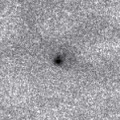
|
It must have brightened up to 11 mag from January to February, but no observations have been reported. Now it is 15.6 mag (Apr. 24, Taras Prystavski). In the Southern Hemisphere, it is observable in the morning sky after this while the comet will be fading. In the Northern Hemisphere, it will be getting higher after July, but the comet will be faitner than 17 mag.
Date(TT) R.A. (2000) Decl. Delta r Elong. m1 Best Time(A, h)
May 30 1 20.25 -10 40.8 2.221 1.851 55 15.8 3:05 (280, -4)
June 6 1 33.71 -10 9.4 2.218 1.904 58 16.0 3:01 (282, -1)
|
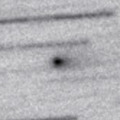
|
Now it is bright as 13.9 mag and visible visually (May 14, Chris Wyatt). In this apparition, it turns to approach to the sun down to 1.17 a.u., and it was expected to brighten up to 13 mag from March to May. But actually, it brightened up to 14-15 mag at best. It will be fading after this.
Date(TT) R.A. (2000) Decl. Delta r Elong. m1 Best Time(A, h)
May 30 21 24.32 -8 5.5 0.504 1.257 107 16.0 3:05 (323, 40)
June 6 21 34.18 -7 17.5 0.511 1.291 111 16.2 3:01 (327, 42)
|
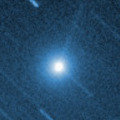
|
It brightened up to 8.2 mag in April (Apr. 8, Juan Jose Gonzalez). Now it is fading rapidly. It was visible visually at 13.2 mag on May 11 (Sandor Szabo). However, it is reported so faint as 18.0 mag on May 20 (A. Diepvens). In the Northern Hemisphere, it is getting lower gradually in the evening sky. It is not observable in the Southern Hemisphere.
Date(TT) R.A. (2000) Decl. Delta r Elong. m1 Best Time(A, h)
May 30 7 59.44 36 33.7 1.908 1.450 48 16.0 20:50 (117, 27)
June 6 8 10.80 34 51.7 2.122 1.568 44 16.6 20:56 (118, 22)
|

|
It brightened up to 13 mag in 2014. Now it is 15.5 mag (Jan. 3, Ken-ichi Kadota). It will be fading slowly after this. It is observable at 16 mag in excellent condition from summer to winter in 2015.
Date(TT) R.A. (2000) Decl. Delta r Elong. m1 Best Time(A, h)
May 30 0 58.87 -0 51.2 4.125 3.642 55 16.2 3:05 (275, 6)
June 6 1 5.37 -0 14.8 4.056 3.657 60 16.2 3:01 (278, 10)
|

|
It brightened up to 13 mag in winter. Now it is fading. It has already faded down to 15.9 mag (May 20, Hiroshi Abe). It keeps observable in good condition for a while.
Date(TT) R.A. (2000) Decl. Delta r Elong. m1 Best Time(A, h)
May 30 11 26.85 13 1.1 2.421 2.768 99 16.2 20:50 ( 56, 56)
June 6 11 32.06 11 54.6 2.545 2.805 94 16.4 20:56 ( 63, 50)
|
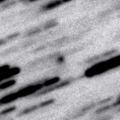
|
It brightened up to 16.4 mag in 2014 (Nov. 14, J. F. Hernandez). It will be observable at 16 mag again from summer to autumn in 2015.
Date(TT) R.A. (2000) Decl. Delta r Elong. m1 Best Time(A, h)
May 30 1 35.31 14 45.0 2.844 2.180 40 16.3 3:05 (257, 8)
June 6 1 48.93 16 7.7 2.807 2.193 43 16.3 3:01 (258, 11)
|
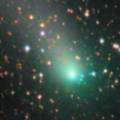
|
It brightened up to 9 mag from autumn to winter in 2014. Now it is fading rapidly. It has already faded down to 14.8 mag (May 26, Yasukazu Ikari). In the Northern Hemisphere, it will be observable in excellent condition after this while the comet will be fading. In the Southern Hemisphere, it is hardly observable after this.
Date(TT) R.A. (2000) Decl. Delta r Elong. m1 Best Time(A, h)
May 30 13 29.22 54 28.1 2.906 3.161 95 16.3 20:57 (180, 71)
June 6 13 13.96 52 59.2 3.056 3.232 90 16.6 20:56 (161, 71)
|

|
First return of a periodic comet discovered in 1994. Now it is 16.9 mag (May 25, MASTER-SAAO Observatory, Sutherland). It will brighten up to 15 mag from summer to autumn, and will be observable in excellent condition in the Southern Hemisphere. It locates somewhat low in the Northern Hemisphere.
Date(TT) R.A. (2000) Decl. Delta r Elong. m1 Best Time(A, h)
May 30 22 27.68 -32 3.8 2.393 2.768 100 16.5 3:05 (323, 11)
June 6 22 35.89 -32 8.0 2.290 2.741 105 16.4 3:01 (326, 13)
|
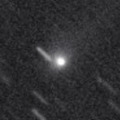
|
Now it is 16.1 mag (May 20, Hiroshi Abe). In the Northern Hemisphere, it keeps 15-16 mag and observable in excellent condition until early summer. It locates somewhat low in the Southern Hemisphere.
Date(TT) R.A. (2000) Decl. Delta r Elong. m1 Best Time(A, h)
May 30 12 40.22 25 30.1 3.645 4.072 107 16.4 20:50 ( 44, 77)
June 6 12 40.24 24 4.3 3.759 4.103 102 16.5 20:56 ( 60, 71)
|

|
Now it is 15.8 mag (May 26, Catalina Sky Survey). It will brighten rapidly, and will be observable at 16.5 mag in good condition from May to July.
Date(TT) R.A. (2000) Decl. Delta r Elong. m1 Best Time(A, h)
May 30 16 27.09 -13 29.7 0.791 1.800 171 16.5 0:00 ( 0, 41)
June 6 16 24.48 -11 51.9 0.784 1.788 167 16.5 23:26 ( 0, 43)
|

|
First return of a periodic comet discovered in 2008. Now it is 17.2 mag (May 19, Catalina Sky Survey). It will approach to the earth from spring to summer, and brighten rapidly. It will brighten up to 16 mag, and will be observable in good condition.
Date(TT) R.A. (2000) Decl. Delta r Elong. m1 Best Time(A, h)
May 30 22 33.35 -5 50.3 0.756 1.267 90 16.7 3:05 (305, 31)
June 6 23 5.97 -5 25.3 0.727 1.241 89 16.5 3:01 (302, 30)
|
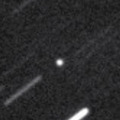
|
Now it is 16.4 mag (May 22, J. Gonzalez). It keeps observable after this while the comet will be getting brighter graudually. It will brighten up to 11 mag from autumn to winter. But it locates low at that time.
Date(TT) R.A. (2000) Decl. Delta r Elong. m1 Best Time(A, h)
May 30 14 3.86 7 42.5 1.323 2.159 134 16.9 21:33 ( 0, 63)
June 6 13 59.45 7 16.7 1.334 2.115 127 16.6 21:01 ( 0, 62)
|

|
Now it is 17.7 mag (Feb. 17, K. Hills). It keeps observable at 17 mag from spring to summer. It locates somewhat low in the Northern Hemisphere.
Date(TT) R.A. (2000) Decl. Delta r Elong. m1 Best Time(A, h)
May 30 17 3.78 -27 24.0 2.176 3.178 169 16.7 0:37 ( 0, 28)
June 6 16 58.81 -26 57.3 2.171 3.184 175 16.7 0:05 ( 0, 28)
|

|
Getting observable again in the morning sky. It is fading, but it is observable at 17 mag in good condition until late autumn.
Date(TT) R.A. (2000) Decl. Delta r Elong. m1 Best Time(A, h)
May 30 23 48.53 12 59.9 6.052 5.717 66 16.8 3:05 (274, 29)
June 6 23 48.99 12 51.0 5.984 5.762 72 16.8 3:01 (278, 33)
|

|
Now it is 17.5 mag (Apr. 27, Hidetaka Sato). It will be observable at 15 mag in good condition in autumn.
Date(TT) R.A. (2000) Decl. Delta r Elong. m1 Best Time(A, h)
May 30 0 11.48 1 33.8 2.558 2.317 64 16.9 3:05 (281, 17)
June 6 0 23.45 2 37.5 2.468 2.296 68 16.8 3:01 (282, 20)
|

|
Now it is 15.8 mag (May 18, MASTER-SAAO Observatory, Sutherland). It keeps observable in good condition until the comet fades out. In 2014, it must have been observable at 14 mag in good condition in the Southern Hemisphere.
Date(TT) R.A. (2000) Decl. Delta r Elong. m1 Best Time(A, h)
May 30 0 30.72 -5 6.2 3.827 3.491 63 16.8 3:05 (283, 10)
June 6 0 35.80 -4 9.5 3.784 3.539 68 16.9 3:01 (285, 14)
|

|
It brightened rapidly in outburst in mid October in 2013, then it keeps bright as 8-10 mag for a long time until 2014 summer. Now it is fading. It has already faded down to 15.8 mag (Feb. 9, Taras Prystavski). In the Southern Hemisphere, it keeps observable in good condition for a long time after this until the comet fades out. It is not observable in the Northern Hemisphere.
Date(TT) R.A. (2000) Decl. Delta r Elong. m1 Best Time(A, h)
May 30 1 23.54 -32 20.4 5.669 5.394 69 16.9 3:05 (298,-16)
June 6 1 28.54 -32 40.7 5.650 5.455 73 17.0 3:01 (301,-13)
|

|
It brightened up to 10.6 mag from autumn to winter (Nov. 29, Seiichi Yoshida). Now it is fading. It has already faded down to 16.7 mag (May 26, Hiroshi Abe). It keeps observable for a long time until the comet fades out.
Date(TT) R.A. (2000) Decl. Delta r Elong. m1 Best Time(A, h)
May 30 17 9.86 -15 20.8 1.900 2.898 167 16.9 0:43 ( 0, 40)
June 6 17 3.09 -15 33.2 1.962 2.971 172 17.2 0:09 ( 0, 39)
|
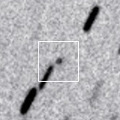
|
Now it is 16.5 mag (May 1, R. A. Mastaler, A. F. Tubbiolo). It keeps 17 mag until summer.
Date(TT) R.A. (2000) Decl. Delta r Elong. m1 Best Time(A, h)
May 30 20 6.23 24 43.2 1.499 2.066 109 17.0 3:05 (322, 77)
June 6 19 33.19 28 30.2 1.442 2.097 116 17.0 2:39 ( 0, 83)
|

|
Now it is 19 mag (May 24, WISE). It will brighten very rapidly, and it is expected to brighten up to 11 mag from summer to autumn. In the Northern Hemisphere, it keeps observable in good condition in the morning sky. It keeps locating extremely low from summer to autumn.
Date(TT) R.A. (2000) Decl. Delta r Elong. m1 Best Time(A, h)
May 30 22 18.16 3 37.2 1.127 1.520 90 17.7 3:05 (300, 41)
June 6 22 40.22 7 21.6 1.020 1.443 90 17.1 3:01 (297, 43)
|
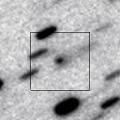
|
Now it is 16.1 mag (May 27, Catalina Sky Survey). It keeps 17 mag until July. It is observable in excellent condition in the Southern Hemisphere. It locates somewhat low in the Northern Hemisphere.
Date(TT) R.A. (2000) Decl. Delta r Elong. m1 Best Time(A, h)
May 30 16 24.98 -23 49.9 1.564 2.578 177 17.1 23:54 ( 0, 31)
June 6 16 19.50 -23 44.8 1.576 2.584 171 17.1 23:21 ( 0, 31)
|
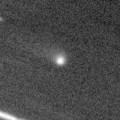
|
Now it is 16.3 mag (Apr. 19, Catalina Sky Survey). It keeps 17 mag for a long time from 2014 to 2016.
Date(TT) R.A. (2000) Decl. Delta r Elong. m1 Best Time(A, h)
May 30 10 45.77 -16 9.6 5.154 5.431 100 17.1 20:50 ( 42, 27)
June 6 10 42.72 -15 38.3 5.286 5.441 93 17.2 20:56 ( 50, 22)
|
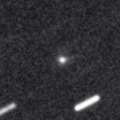
|
Now it is 17.3 mag (May 22, K. Hills). It will brighten up to 14 mag and will be observable in good condition in 2016.
Date(TT) R.A. (2000) Decl. Delta r Elong. m1 Best Time(A, h)
May 30 12 28.73 3 36.5 2.949 3.525 116 17.2 20:50 ( 24, 56)
June 6 12 29.03 3 28.9 3.006 3.491 110 17.2 20:56 ( 37, 53)
|
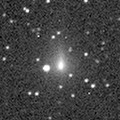
|
It brightened up to 9.5 mag from March to April (Apr. 7, Juan Jose Gonzalez). Now it is fading and getting diffuse rapidly. It was visible visually at 13.5 mag on May 10 (Uwe Pilz). However, it is reported so faint as 19.1 mag on May 28 (C. Rinner, F. Kugel, J. Nicolas). It seems to be a fragment of Comets C/1988 A1 (Liller) and C/1996 Q1 (Tabur).
Date(TT) R.A. (2000) Decl. Delta r Elong. m1 Best Time(A, h)
May 30 11 45.04 46 14.2 1.339 1.641 87 17.2 20:50 (128, 69)
June 6 11 52.11 39 5.6 1.471 1.734 86 18.4 20:56 (107, 66)
|
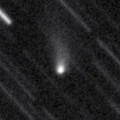
|
It brightened up to 15.3 mag in winter (Jan. 17, Taras Prystavski). Now it is fading. It is observable in good condition in the Southern Hemisphere. It will be observable in good condition after June also in the Northern Hemisphere.
Date(TT) R.A. (2000) Decl. Delta r Elong. m1 Best Time(A, h)
May 30 0 53.98 -19 39.5 2.497 2.284 66 17.4 3:05 (291, -4)
June 6 0 50.60 -18 47.2 2.420 2.324 72 17.4 3:01 (295, 2)
|
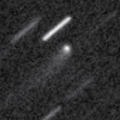
|
Now it is 17.4 mag (Apr. 14, A. Klotz, F. Kugel, J. Nicolas, C. Rinner). It keeps observable at 17-18 mag for a long time from 2013 to 2016. It keeps locating high in the Northern Hemisphere. It keeps locating very low in the Southern Hemipshere.
Date(TT) R.A. (2000) Decl. Delta r Elong. m1 Best Time(A, h)
May 30 15 23.28 65 53.0 6.634 6.740 91 17.4 22:51 (180, 59)
June 6 15 9.03 65 40.1 6.686 6.754 89 17.4 22:09 (180, 59)
|

|
First return of a new periodic comet which brightened up to 12 mag in 2009. It seems to brighten up to 17 mag in summer. It is observable in good condition in the Southern Hemisphere. In the Northern Hemisphere, it keeps locating extremely low after June.
Date(TT) R.A. (2000) Decl. Delta r Elong. m1 Best Time(A, h)
May 30 9 51.57 -6 17.5 1.410 1.657 84 17.5 20:50 ( 60, 26)
June 6 10 5.36 -6 21.7 1.426 1.621 81 17.4 20:56 ( 64, 22)
|

|
Now it is 17.9 mag (Mar. 21, W. Hasubick). It was observed at 17 mag in 2014 summer. In the Northern Hemisphere, it is observable at 17.5 mag in excellent condition also in 2015. It is not observable in the Southern Hemisphere.
Date(TT) R.A. (2000) Decl. Delta r Elong. m1 Best Time(A, h)
May 30 22 10.22 50 4.4 4.343 4.212 75 17.4 3:05 (230, 58)
June 6 22 14.28 51 1.0 4.319 4.236 78 17.4 3:01 (226, 61)
|

|
Very far object. However, outburst occured on Feb. 20, and it brightened up to 15 mag. It was reported so bright visually as 11.8 mag (Mar. 11, Marco Goiato). However, it has already faded down to 17.8 mag (May 16, K. Hills). It locates high in the Southern Hemisphere. But it locates somewhat low in the Northern Hemisphere.
Date(TT) R.A. (2000) Decl. Delta r Elong. m1 Best Time(A, h)
May 30 12 0.80 -20 18.2 8.607 9.138 118 17.8 20:50 ( 22, 32)
June 6 12 1.08 -20 1.7 8.701 9.137 112 17.8 20:56 ( 30, 29)
|

|
Now it is 17.7 mag (May 10, A. Maury, J.-F. Soulier). It has brightened in outburst up to 14 mag twice, in 2006 January and 2011 May. It is around the perihelion now. It keeps observable at 17 mag for a long time after this.
Date(TT) R.A. (2000) Decl. Delta r Elong. m1 Best Time(A, h)
May 30 23 19.11 -3 17.3 5.932 5.820 78 17.8 3:05 (293, 25)
June 6 23 21.92 -3 1.0 5.826 5.821 84 17.8 3:01 (297, 29)
|
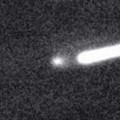
|
It brightened up to 15.5 mag from autumn to winter (Nov. 25, Taras Prystavski). Now it is fading. It has already faded down to 17.8 mag (May 20, A. Diepvens). It keeps observable in good condition for a while.
Date(TT) R.A. (2000) Decl. Delta r Elong. m1 Best Time(A, h)
May 30 17 42.98 -8 15.1 1.640 2.603 156 17.8 1:16 ( 0, 47)
June 6 17 37.20 -8 28.3 1.661 2.646 162 17.9 0:43 ( 0, 47)
|

|
Now it is 19.2 mag (Mar. 22, iTelescope Observatory, Siding Spring). It will be observable at 17.5 mag in good condition in summer.
Date(TT) R.A. (2000) Decl. Delta r Elong. m1 Best Time(A, h)
May 30 23 54.62 0 41.2 1.603 1.561 69 17.9 3:05 (284, 20)
June 6 0 13.77 2 7.7 1.560 1.556 70 17.8 3:01 (284, 22)
|

|
It had been observed at 15 mag for a long time from 2013 to 2014. Now it is fading. It will be observable at 18 mag in good condition from spring to summer. It locates somewhat low in the Northern Hemisphere.
Date(TT) R.A. (2000) Decl. Delta r Elong. m1 Best Time(A, h)
May 30 19 33.35 -30 4.3 4.404 5.194 137 17.9 3:05 ( 0, 25)
June 6 19 31.00 -30 18.9 4.358 5.215 144 18.0 2:36 ( 0, 25)
|
|
![]()
 57P/du Toit-Neujmin-Delporte
57P/du Toit-Neujmin-Delporte C/2014 N3 ( NEOWISE )
C/2014 N3 ( NEOWISE ) C/2014 A4 ( SONEAR )
C/2014 A4 ( SONEAR ) C/2013 X1 ( PanSTARRS )
C/2013 X1 ( PanSTARRS ) 51P/Harrington
51P/Harrington C/2010 S1 ( LINEAR )
C/2010 S1 ( LINEAR ) C/2006 S3 ( LONEOS )
C/2006 S3 ( LONEOS ) 7P/Pons-Winnecke
7P/Pons-Winnecke 218P/LINEAR
218P/LINEAR C/2015 F5 ( SWAN-Xingming )
C/2015 F5 ( SWAN-Xingming ) 117P/Helin-Roman-Alu 1
117P/Helin-Roman-Alu 1 32P/Comas Sola
32P/Comas Sola 44P/Reinmuth 2
44P/Reinmuth 2 C/2013 A1 ( Siding Spring )
C/2013 A1 ( Siding Spring ) 318P/2014 M6 ( McNaught-Hartley )
318P/2014 M6 ( McNaught-Hartley ) C/2013 V2 ( Borisov )
C/2013 V2 ( Borisov ) 221P/LINEAR
221P/LINEAR 319P/2015 G1 ( Catalina-McNaught )
319P/2015 G1 ( Catalina-McNaught ) 10P/Tempel 2
10P/Tempel 2 299P/2014 D2 ( Catalina-PanSTARRS )
299P/2014 D2 ( Catalina-PanSTARRS ) C/2011 J2 ( LINEAR )
C/2011 J2 ( LINEAR ) 61P/Shajn-Schaldach
61P/Shajn-Schaldach C/2015 K1 ( MASTER )
C/2015 K1 ( MASTER ) C/2012 X1 ( LINEAR )
C/2012 X1 ( LINEAR ) C/2014 R1 ( Borisov )
C/2014 R1 ( Borisov ) C/2015 H1 ( Bressi )
C/2015 H1 ( Bressi ) 141P/Machholz 2
141P/Machholz 2 P/2015 F1 ( PanSTARRS )
P/2015 F1 ( PanSTARRS ) C/2013 G9 ( Tenagra )
C/2013 G9 ( Tenagra ) 53P/Van Biesbroeck
53P/Van Biesbroeck C/2015 F3 ( SWAN )
C/2015 F3 ( SWAN ) C/2014 AA52 ( Catalina )
C/2014 AA52 ( Catalina ) C/2012 K8 ( Lemmon )
C/2012 K8 ( Lemmon ) P/2009 L2 ( Yang-Gao )
P/2009 L2 ( Yang-Gao ) C/2013 G3 ( PanSTARRS )
C/2013 G3 ( PanSTARRS ) C/2013 C2 ( Tenagra )
C/2013 C2 ( Tenagra ) 174P/(60558) 2000 EC98 ( Echeclus )
174P/(60558) 2000 EC98 ( Echeclus ) 40P/Vaisala 1
40P/Vaisala 1 220P/McNaught
220P/McNaught P/2012 B1 ( PanSTARRS )
P/2012 B1 ( PanSTARRS )![]()















































